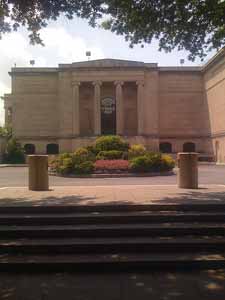-
Baltimore Museum of Art
The Baltimore Museum of Art
began in 1914, with just a single painting, called Mischief and
painted by William Sergeant Kendall. The biggest prize of this
museum, located in Baltimore, Maryland is the Cone Collection that
contains works by van Gogh, Matisse, Renoir, Picasso, Gaugin, Degas,
Monet and Cezanne. Also located in the museum is the pride of Chef
John Shields, Gertrude's Restaurant. The well known architect, John
Russell Pope, was brought in to design the new museum, on land
donated by the John Hopkins University, with three floors, and
numerous rooms that have been copied from six of Maryland's historic
homes. The museum opened in 1929, without too much fanfare, and as
visitors entered, they were met by Rodin's The Thinker, with
numerous items on loan from the Baltimore and Maryland collectors.
Many of these beautiful objects were later donated to the museum and
many of these donors were those that shaped the destiny of the
museum. Presently, the collection contains over 90,000 relics that
have made it the biggest art museum in the state and brings over
300,000 visitors to its antiquities every year. It was one of the
first to acquire a major collection of African artworks, with the
Janet and Alan Wurtzburger collection in 1954, that brought in over
2000 pieces of artworks that range from the periods of ancient Egypt
to today's Zimbabwe and includes works from Ndebele, Bamana, Kuba,
Yoruba and others. The collection includes masks, royal staffs,
textiles, jewelry, pottery, ceremonial weapons, headdresses, figures
and more. Their American collection is one of the best in the
country, that come from the colonial period to today and contain
paintings, decorative arts and sculptures, with numerous works from
the Baltimore area that include; portraitures by Rembrandt Peale and
Charles Wilson Peale, among others, silver from the manufacturing
company of Samuel Kirk & Son, painted furniture by Hugh and John
Finlay of Baltimore and American Baltimore album quilts. The
American paintings include works by John Singer Sargeant, Thomas
Hart Benton, John Singleton Copley, Childe Hassam, Thomas Eakins and
Thomas Sully. Some of the most prestigious canvases hold works by
Thomas Cole in his A Wild Scene, Pink Tulip by Georgia O'Keefe and
La Vachere by Theordore Robinson; as well as prints and drawings,
modern photographs, with artworks by Man Ray, Alfred Stieglitz,
Imogen Cunningham and Paul Strand.
|

